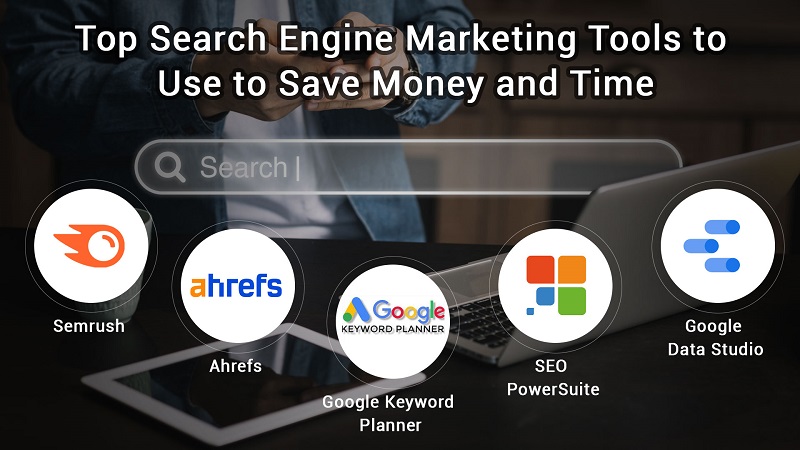What is search engine marketing ?

At its core, SEM is a digital marketing strategy that uses paid advertising to increase a website’s visibility on search engine results pages (SERPs). Unlike Search Engine Optimization (SEO), which focuses on improving organic rankings, SEM leverages paid ads—such as Google Ads or Bing Ads—to place a website at the top of search results for targeted keywords. These ads appear when users search for terms related to a business’s products or services, driving highly relevant traffic to the site. With SEM, businesses can generate immediate visibility, capture potential customers actively searching for specific solutions, and boost conversions.
Understanding what is search engine marketing also involves grasping its key components, such as keyword research, ad copy creation, and bid management. Advertisers choose specific keywords to bid on, set a budget, and pay a fee each time a user clicks on their ad (pay-per-click or PPC). Factors like the relevance of the ad to the search query, landing page quality, and overall user experience determine the ad’s placement and cost. Ultimately, SEM allows businesses to reach a targeted audience quickly, track results, and optimize campaigns in real time, making it a vital tool for companies aiming to drive instant traffic and measurable results from search engines.
__________________________________________________________________________________________________
What are the key components of a successful search engine marketing campaign?
Keyword Research and Selection
The starting point of a SEM campaign is the selection of keywords. They are terms through which potential customers will search for your business on the search engines. Quality keyword research involves finding relevant and highly trafficked keywords that target your products and services. Using tools such as Google Keyword Planner or SEMrush, long-tail keywords can be identified for a good balance between high search volume and low competition.
Ad Copy and Creative Optimization
Writing effective ad copy is crucial to grab attention and drive clicks. Include clear value propositions, align with user intent, and have strong calls to action. Ensure consistency between keywords, ad copy, and landing pages. Test different headlines, descriptions, and CTAs to find what resonates with your audience.
Targeting and Audience Segmentation
SEM enables precise targeting based on location, demographics, interests, and devices. Tailoring ads to specific audience segments boosts relevance and conversion rates. Implement remarketing to target previous visitors who didn’t convert.
Landing Page Optimization
The landing page should match the ad and provide a seamless user experience. Ensure fast load speeds, a clear CTA, and mobile-friendliness. The page must align with the ad’s promise and be designed to convert
The best search engine marketing in kerala
Budget and Bidding Strategy
Effective budgeting and bidding control costs and boost ROI. Use manual, automated, or blended bidding based on campaign needs. SEM often uses CPC, but can also work with CPM or CPA models. Refine bids to stay competitive without overspending.
Trackability, Analytics, and Performance Metrics
SEM allows for real-time performance tracking using tools like Google Ads and Google Analytics. Monitor metrics like CTR, CPC, conversion rate, and ROI. Regularly review data to optimize and identify areas for improvement.
Continuously Testing and Optimizing
SEM requires ongoing testing to ensure success. A/B test elements like ad copy, keywords, and landing pages to find the best performers. Use data insights to refine targeting and optimize campaign performance for better results.
__________________________________________________________________________________________________
What are the benefits of using Google Ads for Search engine marketing?
Instant visibility of your search results
as offered in Google Ads through skipping organic delay and getting direct traffic.High accuracy targeting for the right audience based on keywords, location, device, time, demographics, and user behavior by Google Ads, thus increasing relevance and conversions.Complete control over budgets in terms of daily limits, keyword bids, and cost-per-click models, thereby ensuring efficient and scalable spending.
Measurable Results and Performance Insights
Google Ads offers measurements such as the CTR, conversion rate, and CPC. With such insights, one can make real-time optimization and get an even better ROI because of insightful analytics.
Tuning and Testing Ads
Google Ads enable you to test different copies of ads, different landing pages, and even different keywords to check which works best.
Extended Brand Awareness
Even without clicks, ranking at the top of search results remains effective for brand impression and the Display Network offers the ability to reach users on sites and apps.
Remarketing Campaign Support
Google Ads enable remarketing, focusing on reach users who have visited sites previously in order to increase conversions and remind them about your brand or service.
Scalability
Google Ads is scalable by simply adjusting budgets, adding more keywords or targeting new areas, which makes it suitable for business of all sizes.
Automation and Smart Bidding
Smart Bidding uses machine learning to automatically optimize a campaign’s bids for conversions. Consequently, the automated changes improve the effectiveness of campaigns.
Huge User Base in Google
Google Ads takes 90% of the global share. This represents a significant reach for both local and global markets to businesses.
__________________________________________________________________________________________________
How does search engine marketing work?
Keyword Identification and Search
SEM begins with selecting keywords that target customer searches. Keywords can be short-tail (general) or long-tail (specific). Tools like Google Keyword Planner help determine the best keywords based on search volume and competition.
Create and Set Up an Ad
Once keywords are selected, the next step is creating ads. Write compelling copy and choose the landing page for clicks. A typical SEM ad has a headline, description, and display URL. Align ads with user intent and include a clear CTA, such as “Buy Now.”
Bidding and Budgeting
SEM uses a PPC model. Advertisers bid for keywords, determining the cost per click (CPC). Google Ads runs an auction when someone searches for those keywords. The bid impacts ad position, but other factors matter too.
Ad Rank and Quality Score
In Google Ads, ad position depends on Ad Rank, a combination of bid and Quality Score. Quality Score is based on relevance, click-through rate, and landing page experience.
Ad Auction and Placement
Google runs an auction when a user searches. Ads with the highest Ad Rank win, determined by bid and Quality Score. Winning ads appear prominently, often labeled “Ad.”
Search engine marketing
Monitoring and Optimization
Analytics tools track ad performance in real time. Key metrics include click-through rate, cost-per-click, conversion rate, and ROI. Advertisers can adjust keywords, copy, landing pages, and bidding to improve results.
Target Audience Reach
SEM allows for targeted ads based on location, device, time, and demographics. Advanced targeting ensures ads reach the right audience at the right time.
Remarketing
Remarketing shows ads to users who visited your site but didn’t convert. It encourages them to return and complete a desired action, like making a purchase.
Continuous Optimization
SEM campaigns need ongoing optimization. Advertisers test new keywords, copy, bids, and landing pages. A/B testing helps refine strategies and improve conversions.
__________________________________________________________________________________________________
What is a Quality Score in search engine marketing, and why does it matter?
Quality Score in SEM, the measure for how relevant and effective your ads, keywords, and landing pages are. It is determined by several factors, namely the CTR of the advertisements, the relevance of the ad copy in connection to the actual search query, the landing page experience, and historical performance. Quality Score directly impacts the position of the ad in the search result and the price you pay for each click, or Cost Per Click (CPC). A good Quality Score means your ads can be displayed at a higher position and thus at a much cheaper price. This makes it crucial to optimize the effectiveness and general performance of SEM campaigns. It ensures that users view relevant and high-quality ads, thus optimizing the user experience and function of the advertising platform.
__________________________________________________________________________________________________
What tools can help manage and optimize search engine marketing campaigns?

There are a few robust tools that may be used in the management and optimization of SEM campaigns by businesses. Primary to running SEM campaigns are the Google Ads, which include integrated tools like Keyword Planner that lets advertisers know how to find and then pick the right keywords for a campaign, based on metrics such as search volume, competition, and trends. Some other tools that can be used for bulk editing of campaigns are the Google Ads Editor, which can manage multiple ads and keywords more easily. But Google Analytics also fits in very well with Google Ads and provides valuable insights on the behavior of users visiting landing pages, tracking conversions, and campaign performance all together. In this way marketers can adjust their campaigns according to real-time data to optimize their ad spend and improve their ROI.
Going beyond Google’s own set of tools, third-party platforms such as “SEMrush”, “Ahrefs”, and “Moz” provide resourceful features for keyword research, competitor analysis, and tracking performance. **SEMrush** is a SEM suite that delivers keyword tracking, ad copy analysis, and PPC audit tools to improve bidding strategies. “Ahrefs” is keyword analysis, backlink tracking, and competitive intelligence, which makes it easier to evaluate the competitive landscape and identify gaps in your SEM strategy. Optimizer tools, like “Optmyzr” and “WordStream”, offer advertisers a means to receive automated recommendations, address bid management, and perform A/B testing, thereby refining the campaigns to be as effective as possible regarding outcome. Together, these tools can help make SEM, targeting, and campaign performance perfecting easier by constantly optimizing.
__________________________________________________________________________________________________
What are the most common mistakes to avoid in search engine marketing?
Probably the most common SEM mistake is the failure to do proper keyword research; irrelevant or too-generic keywords have poor campaign performance and wasted ad spend. Determine your most highly relevant, high-intent keywords and use them best in your campaign to match specific products or services you are offering. Furthermore, failing to use negative keywords, or words you do not want your ads to appear for, means clicks from unwanted users, and further spending of your budget, but none of this will convert. Also, continually updating and increasing your keyword list, especially with long-tail keywords, allows you to target your audience more precisely and makes your campaign more effective.
The second biggest mistake is creating ads and landing pages that are not in line, or even worse, not relevant to the search intent. If your ad copy doesn’t match the user’s query or the landing page is not optimized for the keywords you’re targeting, users will probably bounce, putting you in a losing position in terms of lowering click-through rate (CTR) and quality score. This mismatch will drive up costs per click, or CPC, and decrease the overall effectiveness of the campaign. Your ad messaging should be compelling, clear, and directly aligned with the content and purpose of your landing page. Further, landing pages need to load quickly, offer a smooth user experience, and should contain the right kind of content that drives conversions.
Best search engine marketing kerala Thrissur
Lastly, failing to monitor and optimize campaigns regularly has probably sent millions of campaigns into the less desirable suboptimal performance level. SEM campaigns always require constant monitoring. Here, for example, this means fine-tuning bids, testing new ad copies, and evaluating the campaign’s overall performance. If no KPI such as conversion rates, CPC, and return on investment (ROI) is tracked, then there’s a good chance that poor decision-making and missed opportunities will be the problem. Use tools like Google Analytics and Google Ads reporting to analyze campaign data so informed adjustments may be made. A campaign can quickly go from an effective plan to one that is not performing well if it starts well but fails to have the constant A/B testing, bid optimization, and keyword optimization. The continuous refinement based on real-time data is what allows for the maintenance of effective SEM efforts.
__________________________________________________________________________________________________
What is pay-per-click (PPC) advertising, and how does it relate to search engine marketing?
PPC is a type of digital marketing in which advertisers are charged for every click on their ads. PPC is often mostly associated with SEM, in that these search engines like Google Ads and Bing Ads make use of the PPC model to place their ads in their SERPs. For example, an advertiser may submit an ad for bidding on keywords relevant to their business. When a user performs such a search, ads may appear either at the top or even below the organic results. The search service will only charge an advertiser when and if the ad happens to be clicked, making PPC a low-cost way to drive targeted traffic to a website. The purpose of PPC is to attract lead-generating visitors who are actively searching for related products or services, thereby increasing conversion potential.
Search Engine Marketing (SEM): In SEM, PPC is the primary advertising method. In general, SEM is defined as any activity that involves getting visibility on search results via organic optimization or paid advertising methods. Another staple of a SEM campaign is PPC ads. They can immediately, very quickly, give businesses leadership on the SERPs. While organic rankings typically come from SEO and mature over time, PPC ads offer instant results and traffic to businesses. With PPC, an advertiser is able to target an audience based on keywords, location, device types, and more, which helps them derive the right traffic and gain maximum yield from their paid search campaigns.
_________________________________________________________________________________

Leave a Reply